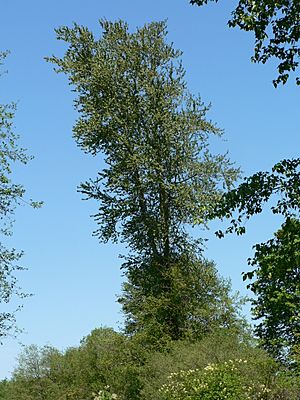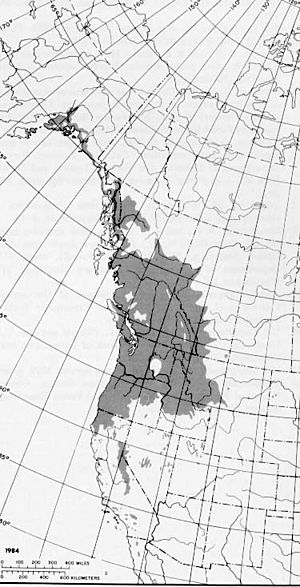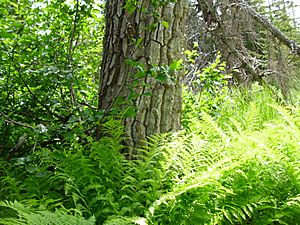Black cottonwood facts for kids
Quick facts for kids Black cottonwood |
|
|---|---|
 |
|
| Black cottonwood | |
| Scientific classification | |
| Genus: |
Populus
|
| Species: |
trichocarpa
|
 |
|
| Range | |
| Synonyms | |
|
|
The black cottonwood (scientific name: Populus trichocarpa) is a large deciduous tree, which means it loses its leaves every year. It's also a broadleaf tree, meaning it has wide, flat leaves. This tree is native to western North America. People use its wood for timber, and it's also important for scientists who study plants.
Contents
About the Black Cottonwood
The black cottonwood is a really big tree! It can grow up to 30 to 50 meters (about 100 to 165 feet) tall. Its trunk can be wider than 2 meters (about 6.5 feet) across. This makes it the largest type of poplar tree in North and South America.
Most black cottonwoods don't live super long, but some can live for up to 400 years! There's even a record-holding black cottonwood in Willamette Mission State Park in Oregon. In 2008, it was measured at 47 meters (155 feet) tall and 9 meters (29 feet) around its trunk.
Tree Parts
The tree's bark is usually grey and has small marks called lenticels, which help the tree breathe. On older trees, the bark becomes very thick and has deep cracks. The branches are grey when they're old and light brown when they're young. The top part of the tree, called the crown, usually looks like a cone and is quite full. On big trees, the lower branches hang down.
The leaves are 7–20 centimeters (about 3–8 inches) long. They are shiny and dark green on top, and a lighter grey-green underneath. Sometimes, on very young or new shoots, the leaves can be even bigger, up to 30 centimeters (12 inches) long. The leaves grow one after another along the branch. They are oval-shaped with wavy edges and a pointed tip. The veins in the leaves form a net-like pattern. The leaf stems, called petioles, are reddish.
The tree's buds are long, narrow, and sticky. In the spring, when they open, they have a strong, sweet smell, like balsam.
Roots
Black cottonwood trees have a very large and strong root system. These roots can spread out a lot and sometimes even cause problems by getting into and damaging drainage pipes. They can also affect building foundations by drying out the soil around them.
How Black Cottonwood Reproduces
Black cottonwood trees usually have separate male and female trees. This means that male flowers (which produce pollen) grow on one tree, and female flowers (which produce seeds) grow on another. The trees start making flowers when they are about 10 years old.
Flowers and Seeds
Flowers can appear from early March to late May in places like Washington and Oregon. In colder areas like British Columbia, Idaho, and Montana, they might appear as late as mid-June.
Male flowers grow in long clusters called catkins. These catkins have 30 to 60 stamens (the parts that make pollen) and are about 2 to 3 centimeters long. They fall off the tree after flowering. Female catkins grow to be 8 to 20 centimeters long when they are mature. Each tiny seed inside the female catkin has long, white, cottony hairs.
Spreading Seeds
The seeds ripen and are released from late May to late June in Oregon and Washington. In Idaho and Montana, this often happens in mid-July. Black cottonwoods usually produce a lot of seeds every year. Because the seeds are attached to their cottony fluff, they are very light and float easily. This allows them to travel long distances by wind and water. The pollen from the male trees can sometimes cause allergies in people.
Even though the seeds can grow easily, they don't last long in nature—only about two weeks to a month. But if they are kept in cold storage, they can last longer.
Growing from Cuttings
Black cottonwood trees are very good at growing from cuttings or broken branches. This is because they have a lot of rooting hormones. After trees are cut down, new trees sometimes grow naturally from pieces of branches that get partly buried in the ground, or from old stumps. New shoots can also grow directly from the roots.
Sometimes, the tree can even drop whole shoots with green leaves. These shoots can then grow roots where they land, or they might be carried by water and root somewhere else. This is one way the tree can spread and grow in new places like exposed sandbars.
Where Black Cottonwood Lives
Black cottonwood trees like to grow in moist places, such as along rivers and streams, or in wet woods on mountain slopes. They can be found from sea level up to about 2,100 meters (about 6,900 feet) high.
They often form large groups of trees in the low-lying areas along big rivers, especially near the Pacific Coast. In drier areas, like eastern Washington, they are only found in protected valleys, along stream banks, and near ponds or meadows. They can grow in many different types of soil, from wet silts and sands to rich dirt and even some clays.
Black cottonwood is a "pioneer species." This means it's one of the first types of trees to grow in new or disturbed areas, like after a flood or fire. Its seeds are numerous and spread widely by their cottony fluff, helping the tree to grow in many places. These trees need a lot of sunlight to grow best. They can handle floods but don't do well in salty water or still, swampy pools.
Where You Can Find It
The black cottonwood grows naturally across a large part of western North America. Its range stretches from Kodiak Island in Alaska down through British Columbia, Washington, and Oregon. It goes as far south as the mountains in southern California and northern Baja California in Mexico.
You can also find it inland, mostly on the west side of the Rocky Mountains, in places like British Columbia, western Alberta, western Montana, and northern Idaho. There are also smaller groups of these trees in southeastern Alberta, eastern Montana, western North Dakota, western Wyoming, Utah, and Nevada. It can grow at elevations up to 2,100 meters (about 6,900 feet).
Black cottonwood has also been successfully planted in other countries. It's one of the most common trees in the Faroe Islands, where there aren't many trees naturally. It was brought to Iceland from Alaska in 1944 and is now one of the most common trees there too.
Growing Black Cottonwood
People also grow black cottonwood as an ornamental tree in their yards and parks. They like it because it grows fast and its leaves smell nice in the spring, a scent you can often smell from far away! However, remember that its roots can spread a lot and might damage building foundations if planted too close, especially in clay soils.
You can even add branches from a black cottonwood to potted plants to help them grow roots!
Why Scientists Study It
The black cottonwood is a great "model species" for scientists who study trees. A model species is an organism that is studied a lot to understand how other similar organisms work. Here's why it's a good model:
- It has a manageable genome size (its genetic code).
- It grows quickly for a tree.
- It starts reproducing in just 4–6 years.
- It's important for the economy (because of its wood).
- It represents a group of trees (the Populus genus) that show a lot of different traits.
Because of these reasons, scientists have studied the black cottonwood a lot. Its entire genetic code (genome sequence) was published in 2006. Scientists have used it to study many things, like how plants respond to certain gases, how wood forms, and how trees handle dry weather.
Uses of Black Cottonwood Wood
The wood from black cottonwood is light, but it's quite strong for its weight. It has short, fine cellulose fibers. These fibers are excellent for making high-quality paper for books and magazines. The wood is also great for making plywood. Living black cottonwood trees are sometimes planted in rows to act as windbreaks, protecting fields or homes from strong winds.
This tree grows very fast. In some tree farms in Great Britain, black cottonwoods have grown 18 meters (about 59 feet) tall in just 11 years, and 34 meters (about 112 feet) tall in 28 years! It can be ready for making pulp (for paper) in 10–15 years, and for cutting into timber in about 25 years.
Other Uses
Native American tribes in the Pacific Northwest used different parts of the black cottonwood for traditional medicines. Because it contains a substance called salicin (similar to aspirin), they used it raw or in salves (ointments) to help with various health problems.
The wood, roots, and bark were also used for many practical things, like firewood, making canoes, ropes, fish traps, baskets, and building structures. The sticky, gum-like sap from the tree was even used as a glue or to make things waterproof. Today, companies sometimes take extracts from the fragrant buds to use as a perfume in cosmetics.
The Black Cottonwood's Genetic Code (Genome)
The black cottonwood was the first woody plant to have its entire genetic code, or genome, mapped out by scientists. Before this, only the genomes of small, non-woody plants like thale cress and rice had been sequenced. Having the black cottonwood's genome helps scientists compare it to other plants and understand how woody plants are different from non-woody ones.
Genome Facts
- Size: Its genome has 485 million base pairs (the building blocks of DNA). To compare, the human genome has about 3 billion base pairs.
- Chromosomes: It has 19 chromosomes.
- Genes: Scientists estimated in 2008 that it has about 45,555 genes, which was the largest number ever recorded for a plant at that time!
- Mitochondrial Genome: The DNA in its mitochondria (the "powerhouses" of the cell) has 803,000 base pairs and 52 genes.
- Chloroplast Genome: The DNA in its chloroplasts (where plants make food) has 157,000 base pairs and 101 genes.
How the Genome Was Mapped
The genome that was mapped came from a single female tree named "Nisqually-1." This tree was found near the Nisqually River in Washington, USA. Scientists used a method called "shotgun sequencing" to read its DNA. This means they broke the DNA into many small pieces, read them, and then put them back together like a puzzle.
Scientists have also found that black cottonwood trees can "fix" nitrogen from the air. This is a special ability usually seen in plants like beans, but it helps the black cottonwood get important nutrients.
Genetic Differences Within One Tree
Interestingly, studies have shown that there can be significant genetic differences between the roots and the leaves/branches of the same black cottonwood tree. The differences within one tree can be as big as the differences between two completely unrelated trees! This discovery is important for scientists who study how living things change over time.
What's in a Name?
The scientific name "Trichocarpa" comes from Greek words meaning "hairy fruits," which describes the tree's seeds.
Here are some other scientific names that are now considered to be the same as P. trichocarpa:
- P. balsamifera subsp. trichocarpa
- P. balsamifera var. californica
- P. hastata
- P. trichocarpa subsp. hastata
- P. trichocarpa var. hastata
- P. trichocarpa var. cupulata
- P. trichocarpa var. ingrata
Images for kids







